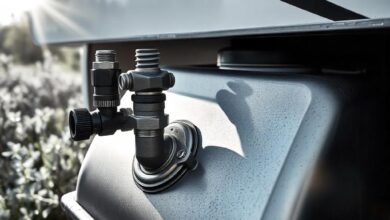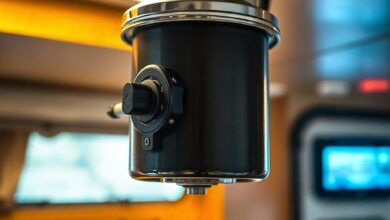Is that helps to add a fan to Rv fridge?
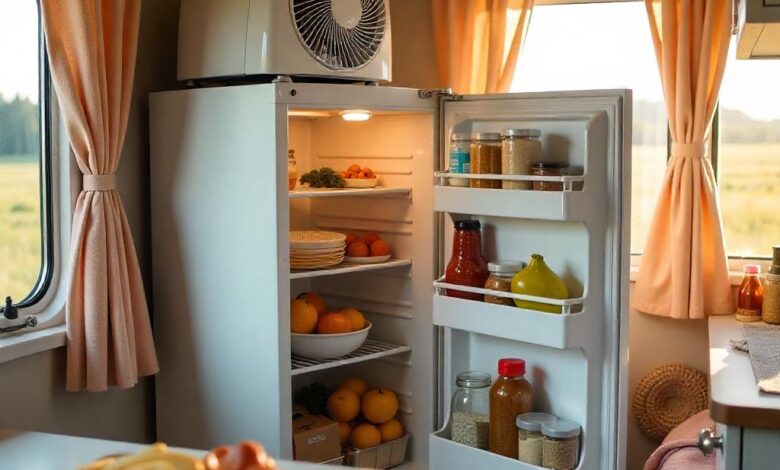
IS that helps to add a fan to Rv fridge? , As find out from this article, recreational vehicles or RVs are a way of life that is full of fun and without much hassle. However, the necessity of always being on the move does not excuse your food from getting spoiled, this is where the RV fridge comes in handy. But keeping the RV cooler cool and the temperature more steady in the often hot climate, can be somewhat of a minor issue. This is where adding a fan to your RV fridge can make a world of difference to the temperature of your food. Here in this blog, the pros of installing a fan, how to do it and how to maintain your RV fridge will be discussed.
Table of Contents
Key Takeaways of Is that helps to add a fan to Rv fridge :
- Adding a fan to your RV fridge boosts cooling efficiency and prevents overheating.
- The fan can improve airflow, reduce cooling time, and maintain even temperatures.
- Fans help save energy by ensuring the fridge’s condenser and evaporator work efficiently.
- RV fridge fans are particularly useful in hot climates or for extended trips.
- You can choose between DIY installation or pre-installed fan kits available on the market.
- Troubleshooting guides can help resolve issues like fan noise or poor airflow.
- Regular maintenance ensures the fan stays efficient and extends the lifespan of your RV fridge.
Understanding How RV Fridges Work?
Now, before getting into whether it would be helpful to add a fan, there is some information to know about how an RV fridge works.
Absorption Cooling Technology
Unlike household fridges, which use a compressor to cool, RV fridges rely on absorption cooling. In this system:
- Heat from propane or electric elements causes ammonia and water to evaporate in the cooling unit.
- This mixture travels through the condenser and evaporator, creating cold air in the fridge.
- Airflow plays a crucial role in dissipating heat from the back of the fridge.
Given this unique system, heat buildup is a significant issue, which can be alleviated by a fan.
Why Adding a Fan to an RV Fridge is Helpful
Adding a fan can directly address issues like uneven cooling, slow temperature drops, and overheating. Here are the key benefits:
1. Improves Airflow
The primary function of an RV fridge fan is to improve the airflow behind and inside the fridge:
- Rear Fan: Helps dissipate heat from the condenser coils, ensuring efficient heat exchange.
- Internal Fan: Circulates cool air evenly inside the fridge, preventing hot spots.
2. Reduces Cooling Time
In hot weather or after restocking with fresh food, RV fridges can take a long time to cool. A fan:
- Enhances the cooling process, allowing the fridge to reach optimal temperatures faster.
3. Maintains Even Temperatures
Fans help eliminate temperature stratification (hot air rising to the top), ensuring that all parts of the fridge maintain a consistent temperature, preserving your food better.
4. Prevents Overheating
Without proper airflow, the fridge’s cooling system can overheat, which not only affects performance but can also cause long-term damage. A fan prevents this by keeping the cooling components at safe temperatures.
5. Saves Energy
By maintaining optimal airflow and cooling efficiency, the fridge won’t have to work as hard, leading to energy savings. This is especially helpful when running on propane or battery power during boondocking (off-grid camping).
6. Extends Fridge Lifespan
An RV fridge that operates efficiently with proper airflow experiences less strain on its cooling system, which in turn can extend its operational lifespan.
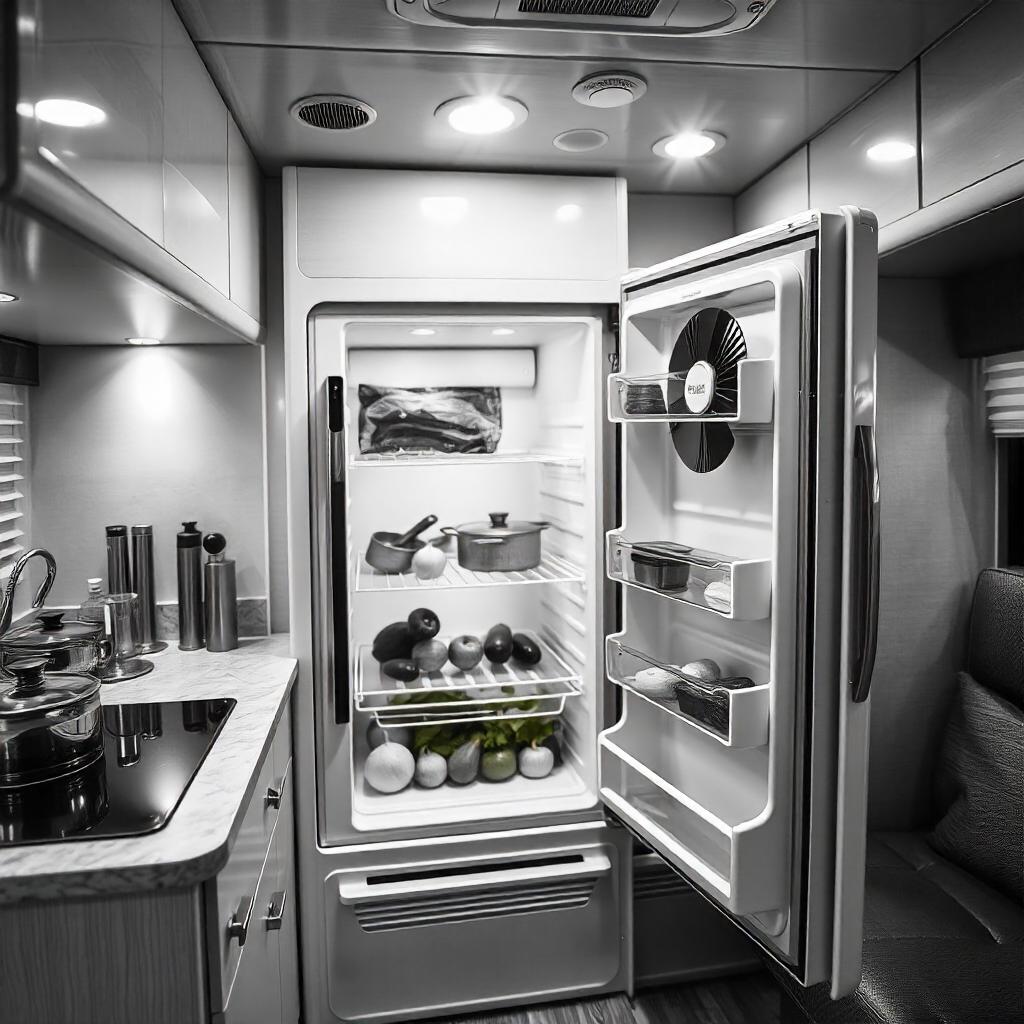
When Should You Add a Fan to Your RV Fridge?
Adding a fan is not always necessary for every RV fridge, but in certain conditions, it can be a game-changer. Consider adding a fan if:
- You camp in hot climates: High temperatures can prevent the fridge from cooling effectively.
- You frequently boondock: Maintaining fridge efficiency is essential when relying on limited power sources like propane or batteries.
- Your fridge is slow to cool: If it takes longer than usual to reach desired temperatures, a fan could help.
- You notice uneven cooling: If your fridge has hot and cold spots, adding an internal fan can help equalize the temperature.
- You’re on an extended road trip: Long periods of fridge use without breaks can lead to inefficiency and overheating.
Types of RV Fridge Fans
When it comes to adding a fan to your RV fridge, there are two primary types to consider:
1. External (Condenser) Fans
These fans are installed behind the fridge, often near the condenser coils, to improve airflow and remove heat more efficiently.
- Pros:
- Directly addresses overheating by increasing ventilation.
- Effective in hot climates or during heavy use.
- Cons:
- Requires access to the back of the fridge for installation.
- Can be noisy if not installed or maintained correctly.
2. Internal (Circulation) Fans
These fans sit inside the fridge compartment, usually attached to the shelves, to help circulate cool air.
- Pros:
- Improves internal temperature consistency.
- Easy to install and requires minimal maintenance.
- Cons:
- Limited in power; works best when paired with an external fan.
Fan Comparison Table
| Fan Type | Purpose | Best For | Pros | Cons |
|---|---|---|---|---|
| External Fan | Improves cooling by enhancing airflow behind the fridge | Hot climates, heavy use, overheating | Enhances cooling efficiency, reduces overheating | Can be noisy, requires back access |
| Internal Fan | Circulates cool air inside the fridge | Uneven cooling, small spaces | Easy installation, improves air distribution | Limited power, not for external cooling |
DIY Installation: How to Add a Fan to Your RV Fridge?
If you decide that adding a fan is the right choice for your RV fridge, you have two options: installing the fan yourself or opting for a pre-installed kit. Here’s a step-by-step guide for those interested in a DIY installation.
Materials Needed:
- RV fridge fan (external or internal)
- Screws or adhesive (depending on fan type)
- Screwdriver
- Wire connectors
- Voltage tester (for electrical connections)
- Zip ties for wire management
Step-by-Step Installation Process
1. Turn Off Power to the Fridge
For safety, disconnect the fridge from all power sources (electricity and propane).
2. Access the Back of the Fridge (for External Fans)
- If installing an external fan, you’ll need to remove the access panel behind the fridge. This will expose the condenser and evaporator coils.
3. Mount the Fan
- Use screws or adhesive to mount the fan near the condenser coils. Make sure it’s positioned to direct airflow over the coils for maximum cooling efficiency.
4. Wire the Fan
- Connect the fan to a 12V power source. Use wire connectors to ensure a secure connection. If you’re not comfortable with wiring, consult an electrician.
5. Test the Fan
- Restore power and test the fan to ensure it’s working correctly. Make sure there’s an increase in airflow and no unusual noises.
6. Install Internal Fans (Optional)
- Interior fans can be mounted that have the clips or adhesive pads for fixing on the fridge shelf. These fans are equipped with batteries meaning that there is no need to wiring the whole system or parts of it.
7. Regular Maintenance
- Clean the fan blades and check the wiring periodically to ensure the fan remains in good working order.
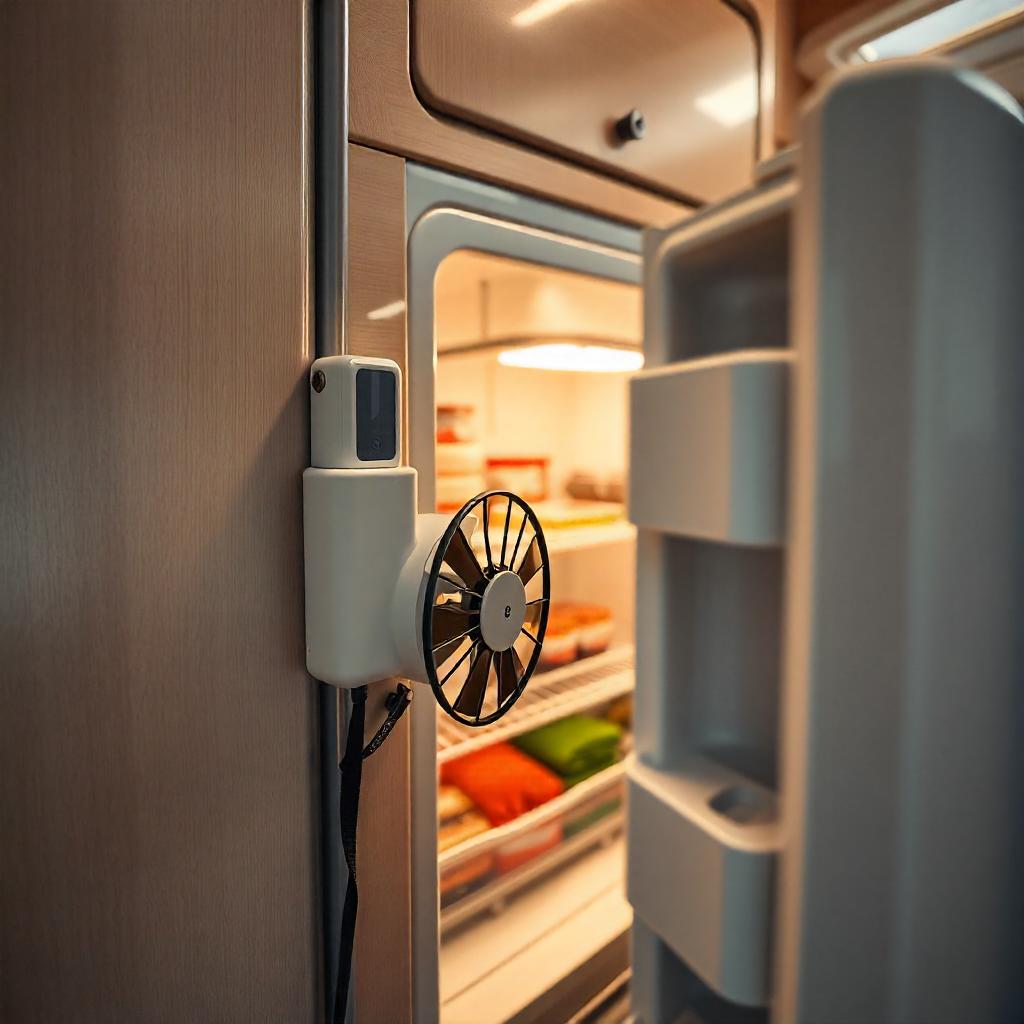
Maintenance Tips for RV Fridge Fans
Like any other component in your RV, the fridge fan requires regular maintenance to ensure it functions efficiently over the long term.
1. Clean the Fan Blades
Over time, dust and debris can accumulate on the fan blades, reducing airflow. Clean them regularly using compressed air or a soft brush.
2. Check for Loose Connections
Ensure that all wires and connections remain secure. If you notice the fan cutting in and out, inspect the wiring for loose connections.
3. Listen for Unusual Noises
If your fan starts making excessive noise, it could be a sign of mechanical wear. Lubricate the motor or replace the fan if necessary.
4. Inspect Ventilation
Ensure that the ventilation behind your fridge is clear and unobstructed. Blockages can prevent the fan from doing its job effectively.
Read Also : What is Tank Heaters on Rv for? : : Can Garden Rubber Pads Work on RV Stabilizer Pads?
Common Issues with RV Fridge Fans and How to Troubleshoot
The fan area should also be cleaned and the wiring checked often so as to warrant that the fan is in proper functioning.
Despite trying to ensure that your RV fridge fan was well installed and maintained, you may experience some problems. Below is a brief checklist that aims at helping you correct your difficulties quickly.
1. Fan Not Working
- Check Power Source: Check whether the fan is connected correctly to the power supply and cut-off and whether the power-cut is on.
- Inspect Wiring: Search for any loose screws or what seems like ‘tears’ on the wires.
- If it is not still working, you can check if it’s receiving electricity using a voltage tester. If not, then the fan might have to be changed along with the connector bTest the Fan: as a result of this model being quite old.
2. Excessive Noise
- Lubricate the Motor: If the fan is noisy then it maybe gets time for a oil change or repair. Grease a small amount of oil to the motor bearings.
- Secure the Fan: Flexible attachment may lead to movement and produce noise.
3. Poor Airflow
- Check for Blockages: Ensure that there’s no debris obstructing the fan blades or the airflow around the fridge.
- Clean the Fan: Accumulated dust on the blades can hinder performance. Clean them regularly to maintain airflow efficiency.
4. Overheating Issues
- Verify Ventilation: Ensure there is adequate space around the fridge for airflow and that the fan is functioning properly.
- Inspect Temperature Settings: Make sure the fridge temperature is set correctly and not too low, which can cause unnecessary strain on the cooling system.
Benefits of Professional Installation vs. DIY
While many RV owners feel comfortable installing fans themselves, hiring a professional can sometimes be beneficial. Here’s a quick comparison:
| Factor | DIY Installation | Professional Installation |
|---|---|---|
| Cost | Generally lower, just the cost of materials | Higher, includes labor fees |
| Time | Can be time-consuming for beginners | Typically faster, done in a few hours |
| Skill Level | Requires basic skills and tools | Expertise and experience guaranteed |
| Warranty | DIY work may not be covered | Professional work often includes warranties |
| Safety | Potential risk if unsure | Ensures safety standards are met |
Choosing between DIY and professional installation often depends on your comfort level with electrical work and your budget.
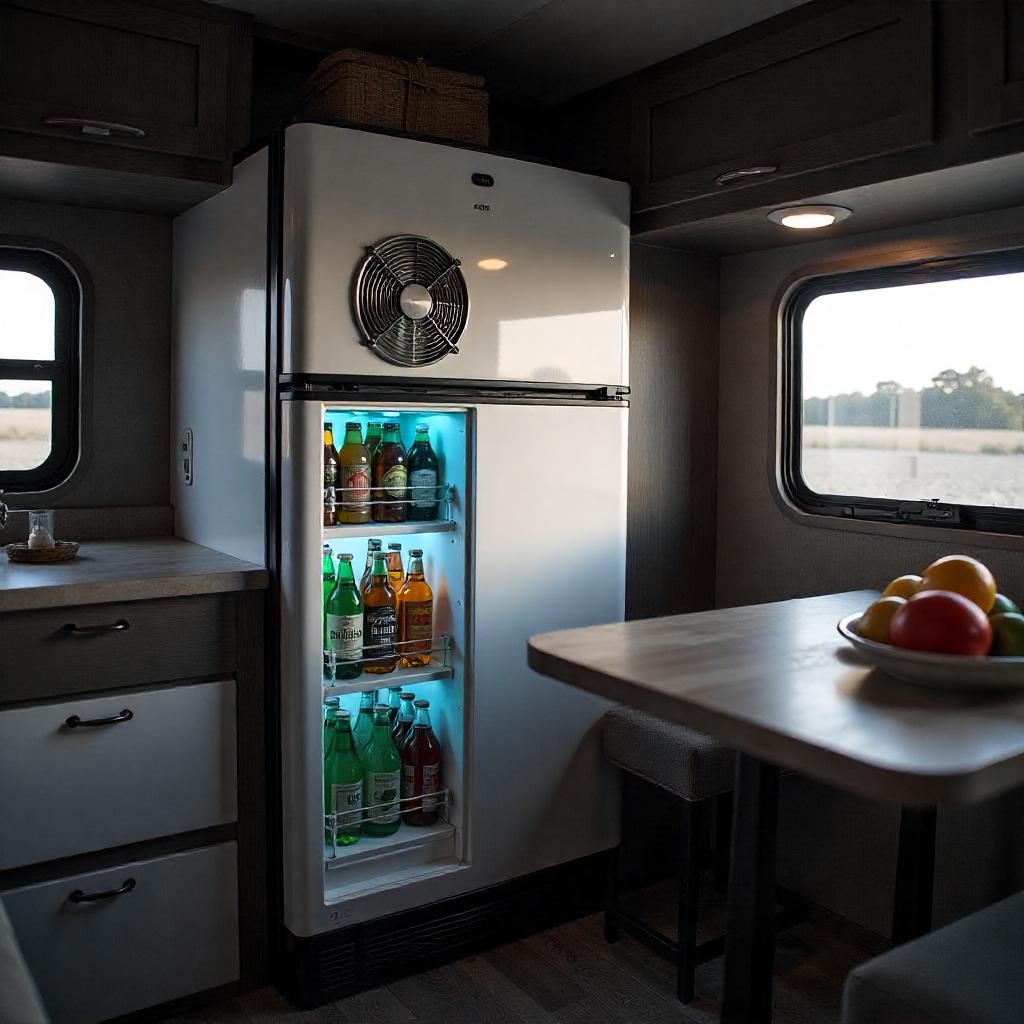
Cost Considerations for Adding a Fan to an RV Fridge
When considering the addition of a fan to your RV fridge, it’s essential to factor in the costs involved. Here’s a breakdown of what you can expect:
| Cost Component | Estimated Cost |
|---|---|
| External Fan Kit | $30 – $100 |
| Internal Fan Kit | $20 – $70 |
| Professional Installation | $50 – $150 (labor only) |
| Tools (if not already owned) | $20 – $100 (varies) |
| Maintenance Supplies (cleaners, etc.) | $10 – $30 |
How Much Will Adding a Fan Save You?
It is practically impossible to put a figure to the amount of money one can save but there is no doubt that having a fan will help to reduce electricity usage as the air conditioning device will operate more effectively. Here are some potential cost savings:
- Reduced Energy Costs: This way you will have saved on the propane or electric bills since fridge tends to work more during summer months.
- Less Frequent Repairs: Another advantage of maintaining the fridge at the right temperature is that it works less hence consuming less power; and most important, because the fridge is not working harder, some parts may not wear out as fast and if they do, they will be expensive to replace.
Conclusion
Therefore, this study concludes that installation of a fan in an RV fridge is an easy fix with significant impact on the unit’s cooling performance, energy conservation, and appliance longevity. With or without professional installation, the knowledge of the benefits and correct care will help you to gain the most from your investment.
In case you often are in hot regions or you would want your fridge to work well during long journeys, installing a fan is a good enhancement. Your RV fridge means you don’t have to worry about spoilage when you are out exploring; all you need is to set it up and take care of it properly.

